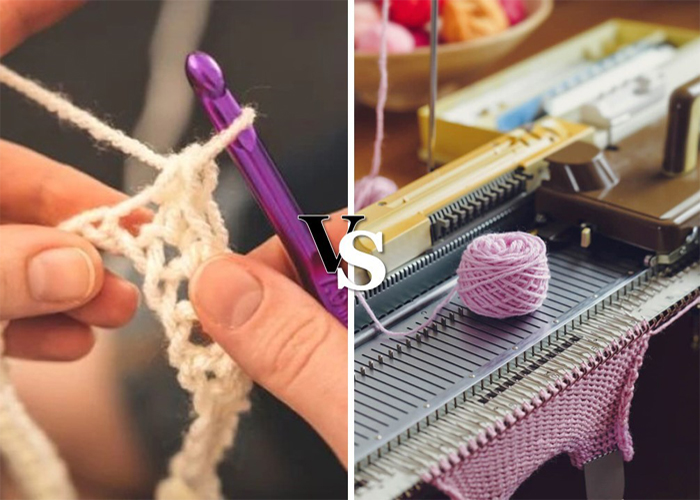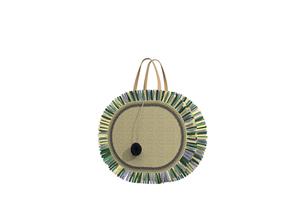Handcrafted Beauty: Why Crochet Can't Be Done by Machine
Handcrafted Beauty: Why Crochet Can't Be Done by Machine

In the world of textile arts, crochet holds a unique position as a craft that, despite advancements in technology, can't be done by machine. This intriguing aspect underscores the importance of manual skill and creativity in producing crochet items. Unlike knitting, which has seen the development of machines capable of creating a wide range of patterns and textures, crochet relies on the intricate manipulation of yarn with a single hook, a technique that machines have yet to replicate successfully. This fundamental difference highlights not only the technical challenges but also the intimate relationship between the crafter and their creation, elevating the value of handmade crochet items in a way that mass production can't match.
The article will explore why crochet machines do not exist, shedding light on the characteristics of crochet that make it resistant to automation. It will delve into the closest mechanical approximations to hand crochet, examining how these technologies fall short of replicating the versatile patterns, textures, and techniques that crocheters achieve with yarn and hook. Further, it will celebrate the special value of handmade crochet items, emphasizing how their uniqueness and the skill required to make them set them apart from machine-made goods. Finally, it will look to the future, considering potential developments in crochet machinery and contemplating whether machines could ever truly replicate the nuanced art of crochet. Through this exploration, readers will gain a deeper appreciation for the craftsmanship and artistry that defines hand-crocheted items.
Why Crochet Machines Do Not Exist
The Unique Nature of Crochet Stitches
Crochet involves intricate hand movements traditionally performed by skilled artisans, making it challenging to replicate accurately using machines. The process requires pulling loops of yarn through other loops to create complex patterns and designs, which demands a level of flexibility and precision that current machinery struggles to achieve.
The Complexity of Replicating Hand Crochet Mechanically
Machines face significant hurdles in replicating crochet due to the complex nature of crochet stitches. Each stitch in crochet is unique and requires specific manipulations that are difficult to mechanize. For example, the crochet hook must pass through loops in previous stitches often more than once, without piercing the yarn, and some stitches require different methods of passing through these loops, such as only using the front or back loop. Additionally, crochet occurs in more dimensions than knitting, which can be somewhat mechanized, adding to the complexity of developing a crochet machine.
Insights from Experts on the Challenges of Creating Crochet Machines
Experts like Dr. Gail Kenning and museologist Cary Karp highlight the technical challenges and the dexterity needed in crochet, which further complicate the development of crochet machines. According to Dr. Kenning, the free-flowing nature of crochet and the manual dexterity required make it unlikely for machines to replicate this craft accurately. Cary Karp points out that there is no existing mechanism capable of making the transverse chains that define hand crochet, underscoring the absence of machines that can produce true crocheted fabric.
In summary, while some advancements in technology have led to machines that can simulate aspects of crocheting, they still fall short of replicating the authentic look and feel of hand-crocheted items. The artistry and manual complexity involved in crochet remain barriers that technology has yet to overcome.
The Closest Mechanical Approximation to Hand Crochet
Introduction to Warp Knitting Machines
Warp knitting machines represent the closest mechanical equivalent to hand crochet, utilizing hooked needles to approximate a crochet look. Despite their similarities to hand crochet, these machines cannot fully replicate the intricate techniques of hand crochet. Initially developed in the 18th century, the warp knitting machine has evolved, yet the core mechanics still reflect a strong resemblance to hand crochet operations. The addition of warp guides to the frame allowed yarn to be manipulated in ways somewhat similar to crochet, marking a significant advancement from earlier knitting technologies.
Differences between Warp Knitting and True Crochet
The fundamental difference between warp knitting and true crochet lies in the loop formation and the fabric structure. In warp knitting, all loops are held open, unlike in crochet where each stitch is closed as the fabric is made, leaving only one loop open at a time. This structural difference changes the fabric's characteristics, making warp knitting more akin to knitting than crochet in terms of texture and stretchiness. Additionally, while warp knitting machines can create chain stitches similar to those in crochet, they lack the ability to produce the transverse chains that are definitive of hand crochet.
Why Warp Knitting Machines Cannot Fully Replicate Hand Crochet
Despite the advancements in warp knitting technology, several factors prevent these machines from fully replicating hand crochet. The machines use multiple needles and involve mechanical processes that cannot match the manual dexterity and varied stitch patterns achievable in hand crochet. Crochet involves not only vertical but also lateral and more complex manipulations of yarn with a single hook, which current machines cannot duplicate. Moreover, the tactile feedback and adjustments a crocheter can make in real-time are impossible to replicate with a machine, which operates under preset conditions without the nuanced adjustments a human can perform.
The exploration of these mechanical approximations highlights both the limitations of current technology and the unique, irreplaceable value of handcrafted crochet items, emphasizing the artistry and skill involved in traditional crochet techniques.
The Special Value of Handmade Crochet Items
The Exclusivity and Authenticity of Hand Crochet
Handmade crochet items carry an inherent value of exclusivity and authenticity that is highly prized. Each piece is unique, often reflecting the personal touch and style of the crafter. This individuality cannot be replicated by machines, making each hand-crocheted item a one-of-a-kind work of art.
The Impact of Knowing Every Crochet Item is Handmade
The knowledge that every crochet item is handmade adds significant emotional and cultural value to these pieces. Consumers appreciate the time, effort, and skill invested in each item, which often translates into a willingness to pay a premium for genuine handmade products. This appreciation is rooted in the understanding of crochet as an art form that requires a high level of manual dexterity and creativity.
The Appreciation for the Skill and Artistry Involved in Crochet
The skill and artistry involved in creating crochet items are deeply appreciated by both crafters and consumers. This appreciation is evident in the thriving communities of crochet enthusiasts who value the intricate patterns and the personal expression that crochet embodies. The process of creating crochet items provides a therapeutic and satisfying experience for the crafter, while consumers enjoy the beauty and craftsmanship of the finished products.
Potential Future Developments in Crochet Machinery
Possibilities and Challenges in Developing a True Crochet Machine
The development of a true crochet machine presents both possibilities and significant challenges. While it is technically feasible to create a machine that can perform basic crochet functions, the intricate nature of crochet stitches makes it difficult to fully mechanize the process. Current machines, such as warp knitting machines, approximate certain crochet techniques but cannot replicate the full range of stitches and textures unique to hand crochet. These machines use multiple needles and threads, which diverges from the single-hook, single-thread approach of traditional crochet, limiting their ability to produce genuine crochet patterns.
The Role of Research and Development in Mechanizing Crochet
Advancements in technology could potentially close the gap between hand crochet and machine-produced textiles. Research and development play a crucial role in this endeavor, focusing on computational tools that can mimic the complex movements required for crochet stitches. Innovations such as robotic arms and digital fabrication methods are being explored to automate the crochet process. These technologies aim to replicate the manual path of crochet hooks and manage yarn tension, which are critical for maintaining the integrity of crochet stitches. However, the success of these technologies in fully automating crochet remains to be seen, as the tactile feedback and adaptability of human crocheters are challenging to replicate mechanically.
Comparing the Likelihood of Crochet Machines with the Existence of Knitting Machines
The existence of knitting machines and their efficiency in producing knitted garments highlight the disparities between knitting and crochet mechanization. Knitting machines, which have been in use for decades, efficiently produce fabric using less yarn and are well-suited for mass production of clothing. In contrast, the complexity of crochet, requiring manual dexterity for manipulating the yarn and hook, makes it less likely to be fully mechanized. Although some industrial machines are referred to as crochet machines, they are essentially warp knitting machines and do not perform true crochet stitches. This distinction underscores the unique challenges in developing a machine capable of replicating the diverse and intricate stitches of hand crochet.
Conclusion
Throughout this exploration, we've delved into the intricacies and nuances that make crochet a uniquely human craft, beyond the reach of current mechanization efforts. From the complexities of crochet stitches that demand manual dexterity and creativity, to the distinctive value and appreciation attributed to handcrafted crochet items, it's evident that the art of crochet stands as a testament to the irreplaceable nature of human touch in creativity. This understanding not only heightens our appreciation for the craft but also reinforces the notion that some aspects of artistry remain solely within the realm of human capability, unduplicated by the most advanced technologies.
Looking ahead, the potential for future technological advancements to bridge the gap between handcrafted and machine-produced crochet presents both an intriguing possibility and a formidable challenge. Yet, even as research continues into making crochet more accessible through mechanization, the essence of crochet as an expression of personal creativity and skill asserts its enduring value. The journey of crochet, from a manually intensive craft to the cusp of technological innovation, underscores an essential truth: the convergence of art and technology magnifies the beauty of human creativity, even as it strives to replicate it.
As we continue to explore ways to make crochet more accessible through mechanization, we remain committed to the core values that define us. Our factory, home to over 1000 skilled artisans, is the heart of HANDBRAID's success. These artisans are not just the backbone of our company but the wellspring of our creativity, allowing us to continue producing exquisite handcrafted pieces that embody both technical skill and artistic vision. Our crochet handbags and braided storage baskets stand as testaments to the craftsmanship we uphold, each piece uniquely designed and infused with artistic value.
FAQs
1. Why is crochet only possible by hand?
Crochet involves creating intricate patterns using a spool of yarn and a crochet hook, a process that requires the unique dexterity of human hands. Machines are currently unable to replicate the complex manipulations needed for this centuries-old art form.
2. Are there any machines that can perform crochet stitches?
No, there are no machines that can perform true crochet stitches. While there are factory machines that produce items labeled as "crochet" or "crochet lace," these typically involve techniques like embroidery on a net background or variations of weaving, not actual crochet.
3. Can factory machines produce true crochet items?
True crochet cannot be achieved by factory machines. The products often referred to as machine-made "crochet" are actually created through methods other than authentic crochet, such as embroidery or weaving techniques.
4. Is crochet exclusively a handmade craft?
Yes, all crochet is done by hand since no machine has been developed that can replicate the handmade crochet process. Unlike knitting, which can be done by machines and is often found in mass-produced knitwear in stores, crochet remains a purely manual craft.




